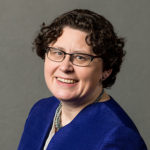
Elizabeth A. Clark is Associate Director, International Center for Law and Religion Studies and Regional Advisor for Europe at the J. Reuben Clark Law School, Brigham Young University
In a moment that would have repercussions throughout the Orthodox world, on January 5, 2019, Ecumenical Patriarch Bartholomew officially recognized a new Orthodox Church of Ukraine (OCU). An act that may seem like an obscure internal jurisdictional shift to outsiders, Patriarch Bartholomew’s grant of a Tomos of autocephaly (an ecclesiastical grant of independence) reflects and contributes to the highly politicized role that religion has played in the Russian-Ukrainian conflict and contains the potential to dramatically change the role of religion in Ukrainian public life for years to come.
Up until the grant of the Tomos, Orthodox churches in post-Soviet Ukraine were divided among three denominations: the Ukrainian Orthodox Church headed with a patriarchate in Kyiv (a post-Soviet creation), the Ukrainian Autocephalous Church (with ties to pre-Soviet Ukraine), and the largest, the Ukrainian Orthodox Church loyal to the Moscow Patriarchate (associated with the Russian Orthodox Church). Neither of the first two, Kyiv-headed churches enjoyed canonical status in the eyes of other Orthodox globally, but the Ukrainian public and political establishment became increasingly uncomfortable with the canonical church’s ties to the Moscow Patriarchate.
As detailed in the new volume that Dmytro Vovk and I edited, Religion during the Russian-Ukrainian Conflict, Russia’s accession of Crimea and involvement in the fighting in eastern Ukraine, Putin and Russian Patriarch Kirill’s use of a common religious heritage to defend a broader geo-political “Russian world,” together with the unwillingness of the Russian Orthodox Church to acknowledge the legitimacy of the Ukrainian cause during the conflict led many Ukrainians to believe that a new autocephalous Ukrainian Orthodox Church was needed, one that enjoyed canonical recognition and could unify the two Kyiv-headed denominations (and potentially all three branches of the Ukrainian Orthodox Church).
In April 2018, the Ukrainian Parliament and President Poroshenko requested that the Ecumenical Patriarch (the first among equals in the Orthodox world) grant recognition of a new Ukrainian Orthodox Church, one that would be under the authority of the Ecumenical Patriarch instead of Moscow. This grant given a year ago and the subsequent consolidation of most of the non-Moscow Patriarchate Ukrainian Orthodox churches (and many of the Moscow Patriarchate parishes that left to join it) will continue to shape religious life in Ukraine for many years to come.
The creation of an autocephalous OCU also has had international repercussions. The Russian Orthodox Church has refused to recognize it and has broken communion with the Ecumenical Patriarchate over the issue. Other Orthodox churches feel pressured to take sides. Russia has claimed that the U.S. instigated the creation of the OCU. The political defeat of Poroshenko, who ran on a motto of “Army, Language, and Faith” by the less-religious Volodymyr Zelenskiy has raised questions about the future of the relationship between the Ukrainian Orthodox Church and the Ukrainian state.
In this Talk About Converstaion, thoughtful authors examine various facets of the grant of autocephaly and its broader impact:
Dmytro Vovk looks at the religion policy of President Zelensky and considers to what extent he has fulfilled predictions of distancing himself and his government from Poroshenko’s support of the new Orthodox Church of Ukraine and his vision of a strong role for religion in public life. Andriy Fert explores the impact of the OCU’s creation on the Ukrainian Orthodox Church of the Moscow Patriarchate and the church’s resulting narratives.
Catherine Wanner and Tetiana Kalenychenko suggest the possibility that, despite the creation of the OCU, churches in Ukraine may play a different role in society than in other Orthodox countries, looking particularly at the ways that chaplaincy has been playing out in Ukraine. They suggest that religion in Ukrainian public life may take a more non-denominational form with religiously-infused practices and values influencing social institutions rather than follow a typical Orthodox “national church” model.
Andrii Krawchuk extends this notion, emphasizing that the OCU needs to start healing relations with the Russian Orthodox Church and the Ukrainian Orthodox Church loyal to it and resist being coopted by the state, instead becoming a partner in forming a political culture that respects the independence of religious associations. He describes the polarizing repercussions of the propaganda war that ran parallel to the fighting in eastern Ukraine and challenges both the OCU and Ukrainian Orthodox Church of the Moscow Patriarchate to move beyond the discourse of separation and polarization.
Robert C. Blitt looks at the role of the Tomos in an international context. Blitt examines the Moscow Patriarchate’s charge that the U.S. was behind the creation of the OCU, and concludes that such action would have been ineffective, unnecessary, and unlikely.
See the links to the individual posts, below:
-
- Dmytro Vovk, Religious Policies under President Zelensky
- Andriy Fert. A Year after the Tomos: The Moscow Patriarchate’s Narratives about the New Church and Itself
- Catherine Wanner and Tetiana Kalenychenko. From Chaplains of Maidan to Military Chaplains: One Year after the Tomos
- Andrii Krawchuk, The Orthodox Church of Ukraine: Can Relations with the Russian Orthodox Church Be Normalized?
- Robert C. Blitt, U.S. Interference in Ukraine’s Autocephaly: An Ineffective, Unnecessary, and Unlikely Affair
